This post may contain affiliate links. Please see our disclosure policy.
Canning butternut squash soup base is a delicious way to have a home-cooked meal in a jar ready right on your pantry shelf. Since butternut squash cannot be canned as a puree, this recipe cans butternut squash soup as chunks, and you simply puree the soup before heating and serving. Everything’s in the jar, cooked and ready to puree, heat and eat.
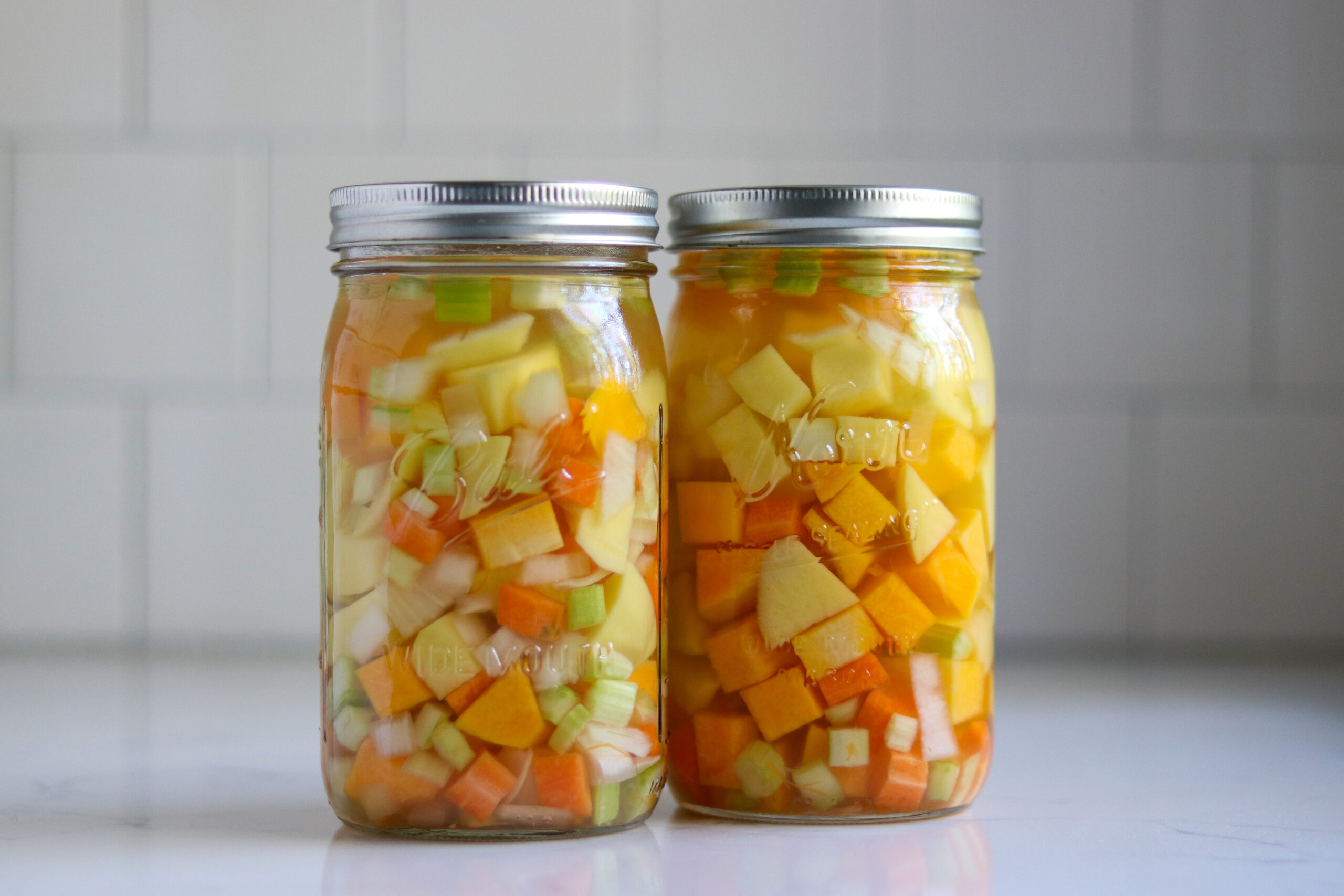
Does anything say “fall” quite like butternut squash soup? We think not!
Nothing compares to the taste and freshness of homemade butternut squash soup base – so why not make it a year-round staple in your pantry?
Pressure canning is the safest and most effective way to preserve low-acid vegetables like squash, providing you with a safe way to extend their shelf life for up to 18 months (and sometimes even longer).
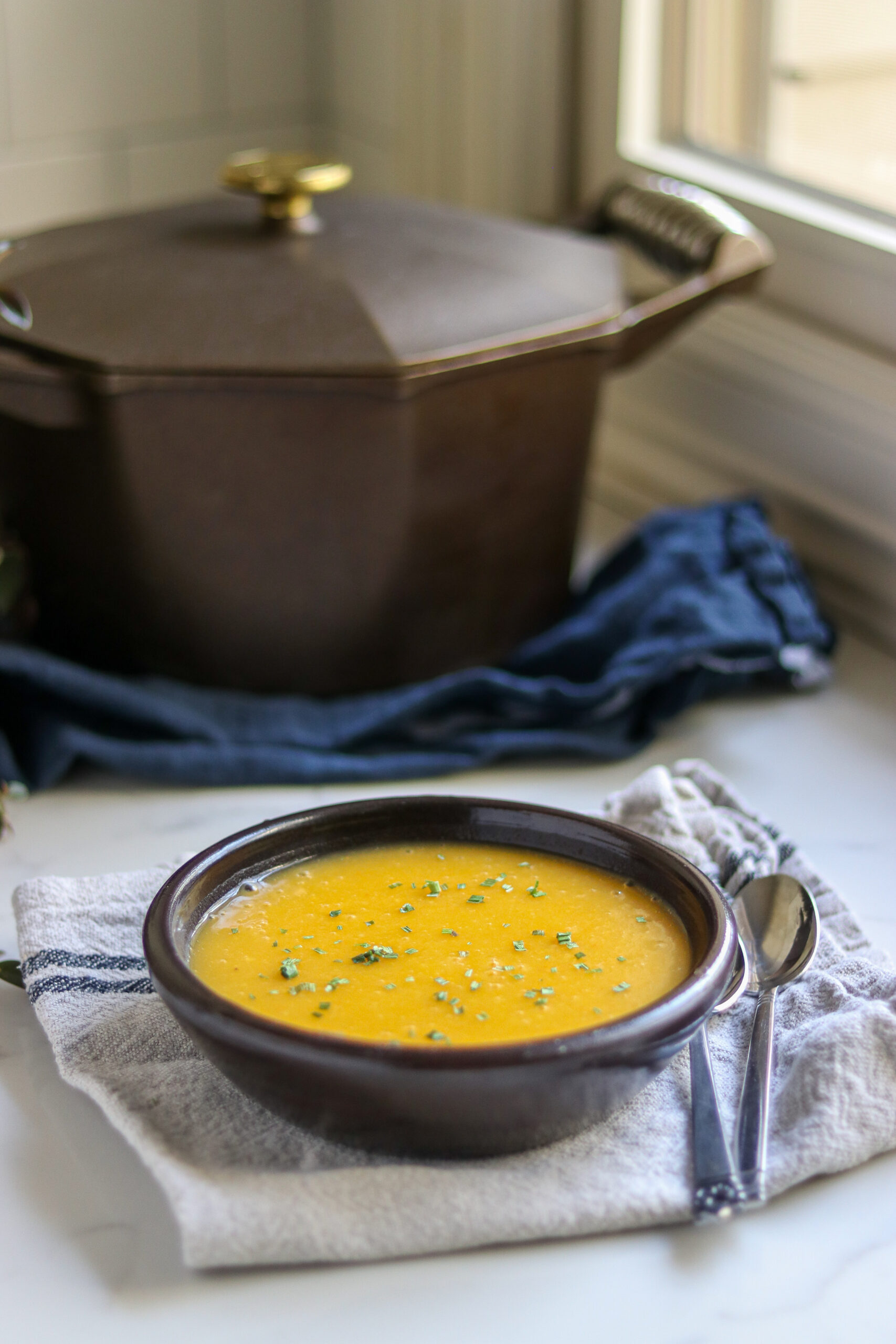
Butternut squash is perhaps the most popular squash for canning because it is the easiest to peel and cube. All you have to do is peel your squashes with a vegetable peeler, cut in half, then remove the seeds. Easy enough, and you can even save the seeds for roasting and snacking later on.
The beauty of this recipe is that it creates a soup base that can be served on its own or used as a starting point for all kinds of recipes, including pastas, more complex soups and stews, and sauces. It’s versatile and highly nutritious.
Here, we’ll show you how to pressure can butternut squash soup base at home, giving you an incredibly delicious and nutritious meal that will last all winter long!
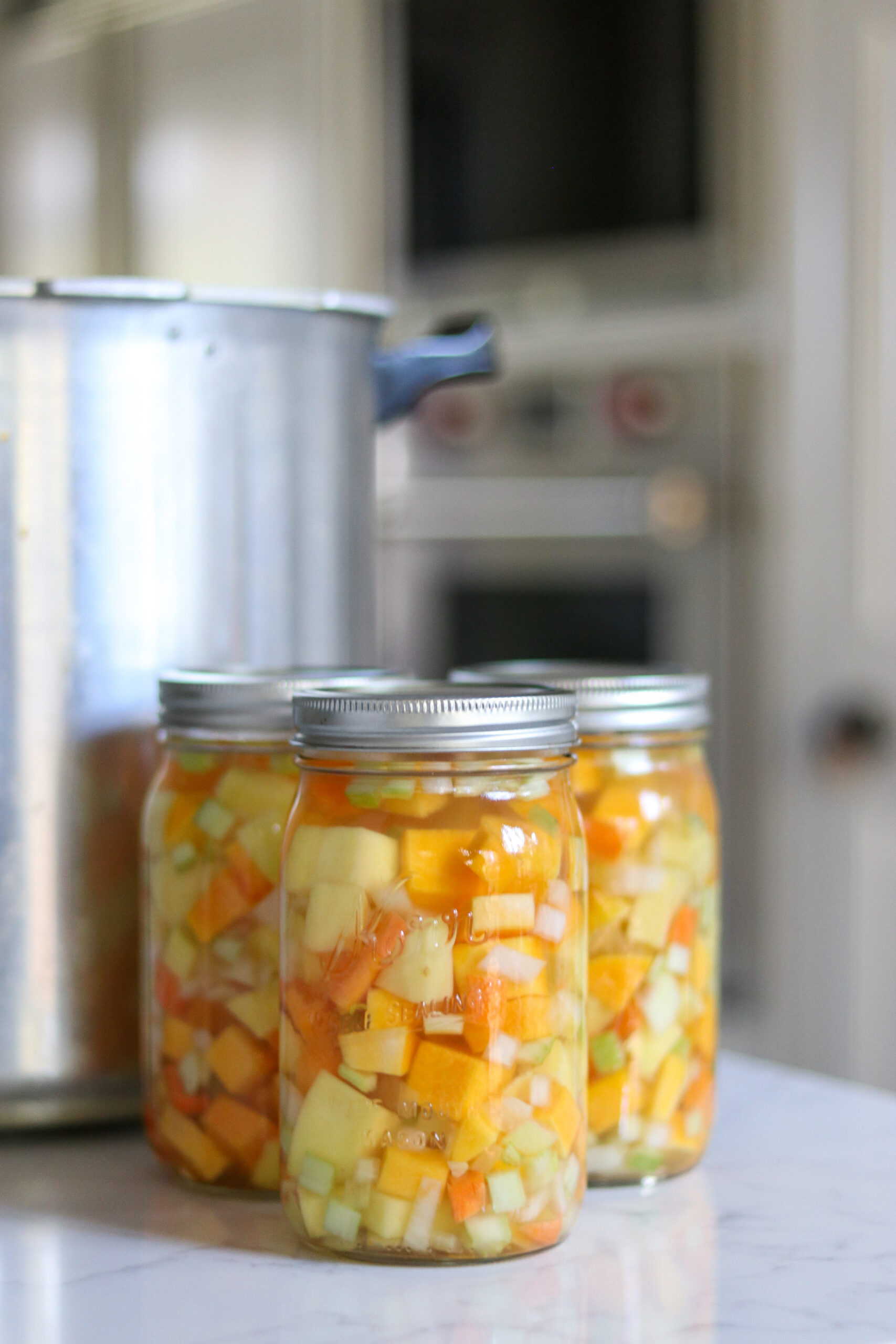
Ingredients for Canning Butternut Squash Soup Base
This recipe is adapted from the Homestead Canning Cookbook by Georgia Varozza.
It’s based on the instructions for canning pumpkin and other winter squash, as well as the National Center for Home Food Preservation’s instructions for canning soup at home.
It follows all the principles of home canning, and cans the squash as a soup base that’s pureed to serve (rather than pureed in the jars before canning).
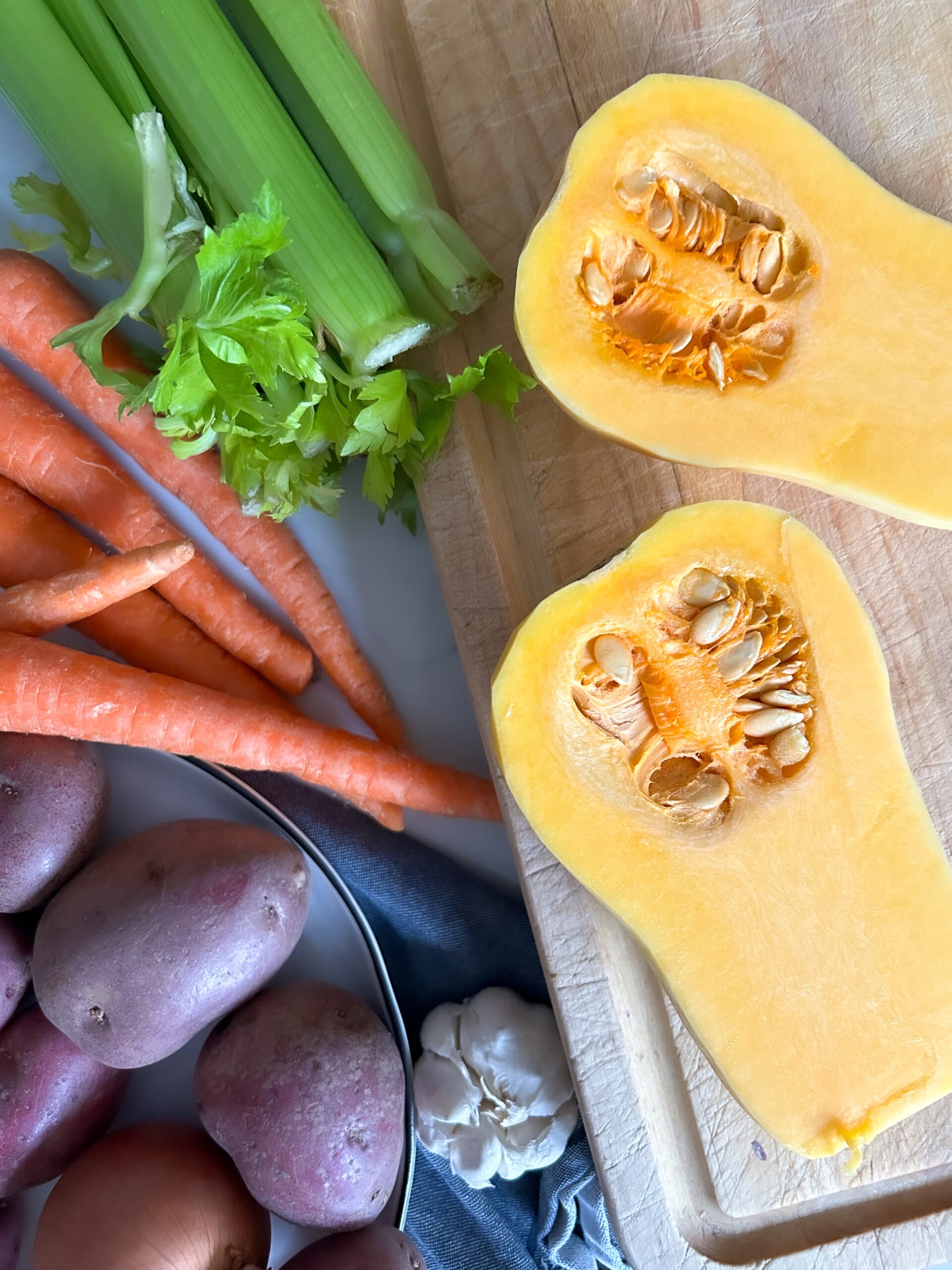
This recipe for canning butternut squash soup base is pretty basic, and it uses butternut, onions, celery, carrots, and potatoes, which give the finished soup a bit of body and creaminess.
You can add in whatever spices you like, as you’re always allowed to add reasonable amounts of dry spices to any canning recipe. That’s one of the lovely things about pressure-canning soup recipes in general. You can make them your own simply by changing up the spices.
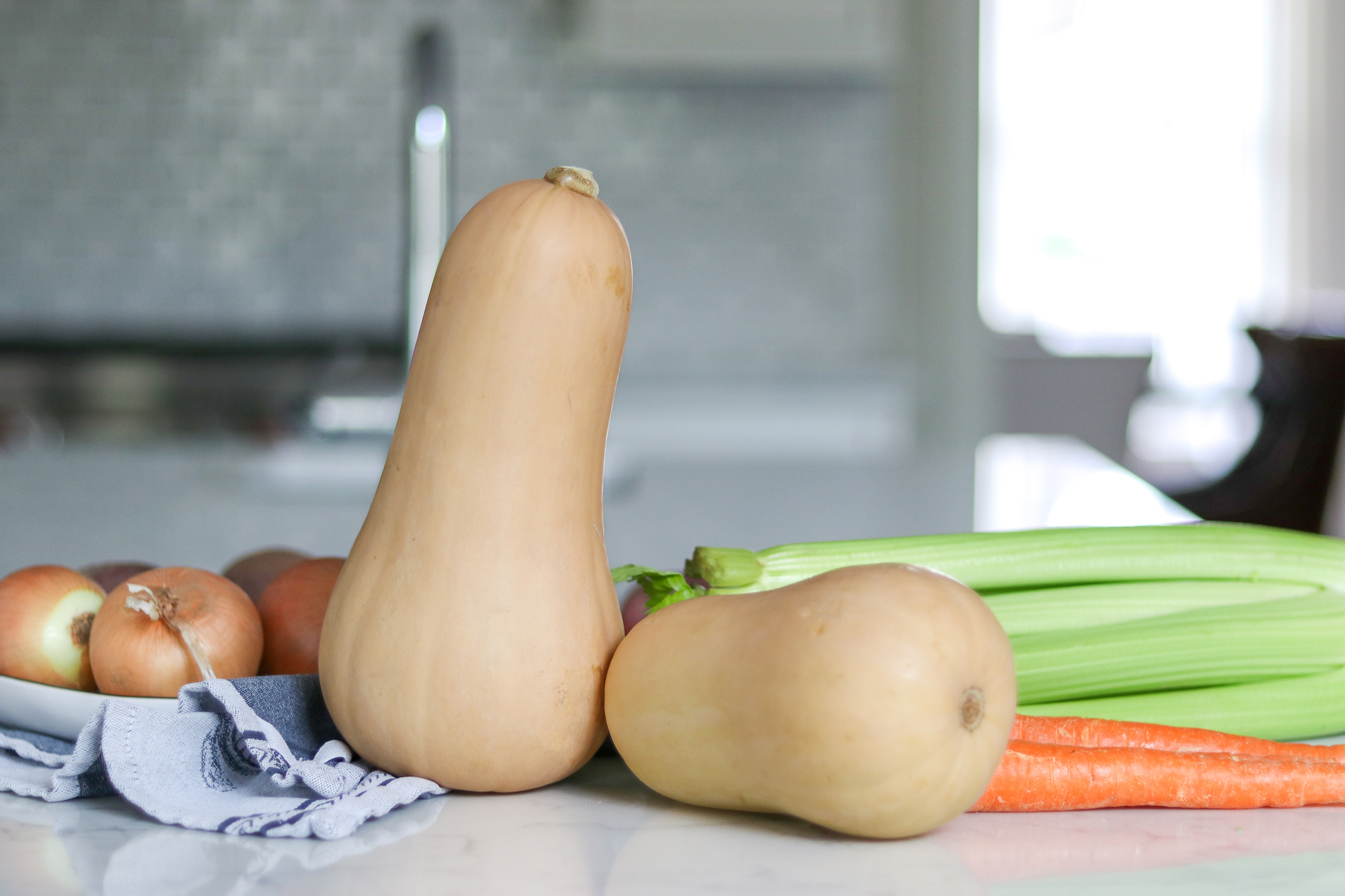
You’re also allowed to add sugar (as well as honey, maple, or my favorite in butternut squash soup, homemade apple cider syrup (you can also buy Vermont made cider syrup online). Just a dash of it goes a long way, and really makes the flavors of this simple butternut squash soup pop.
Alternatively, you can replace some of the broth, maybe about 1/3 of the total, with fresh apple cider for amazing flavor.
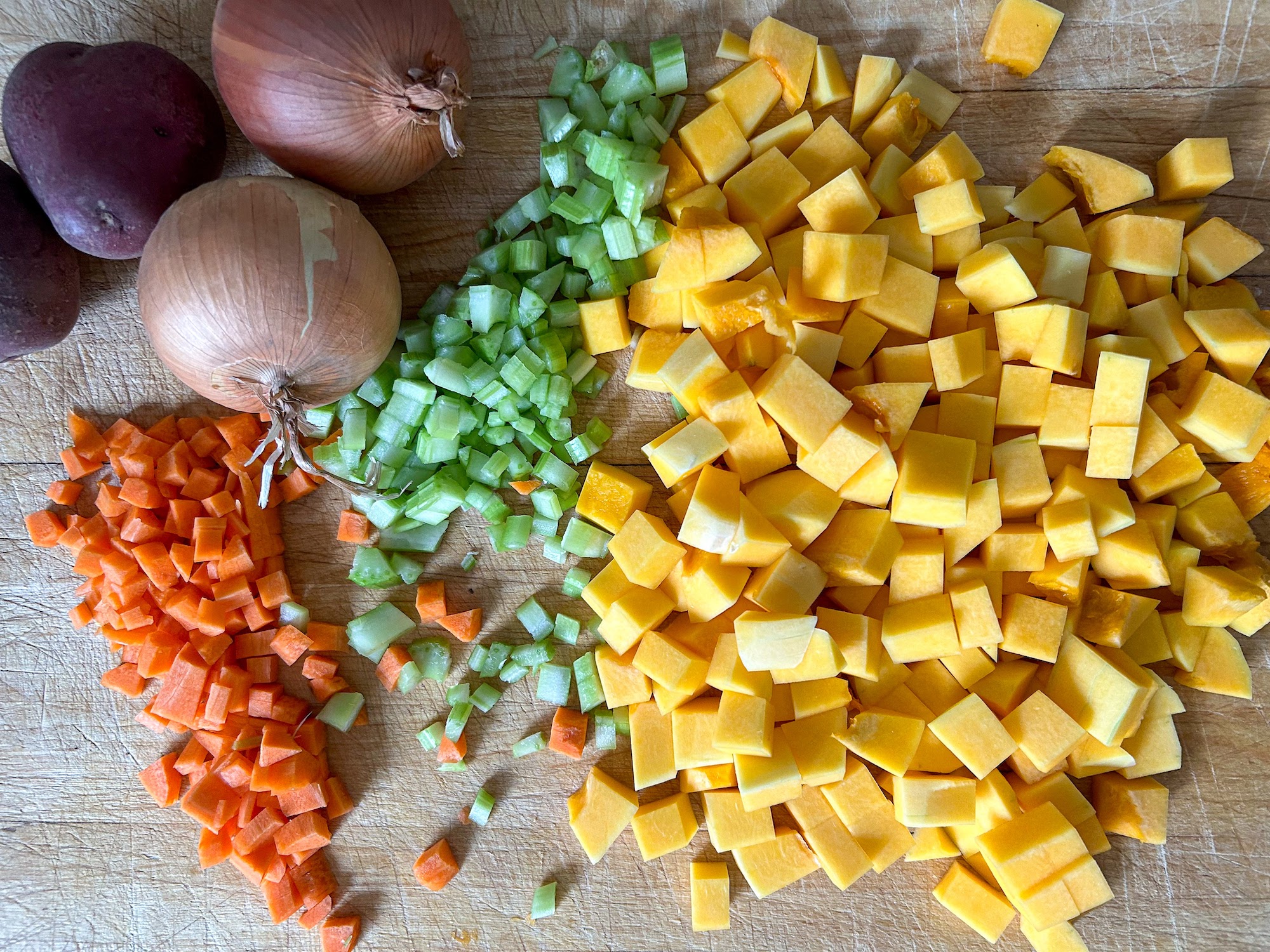
Canning butternut squash soup base is easy and requires just a few simple ingredients. To make a canner batch of 10 pints or 5 quarts of soup, you’ll need the following:
- 5 lbs butternut squash, peeled and cubed into ½ inch pieces
- 2 ½ lbs red potatoes, peeled and cubed into ½ inch pieces
- 5 stalks of celery, chopped
- 5 carrots, chopped
- 3 onions, chopped
- 2 tablespoons of salt
- About 3 quarts water or broth to cover the vegetables in the jars
You can use any kind of butternut squash, potatoes, carrots, celery, and onions you’d like for this recipe.
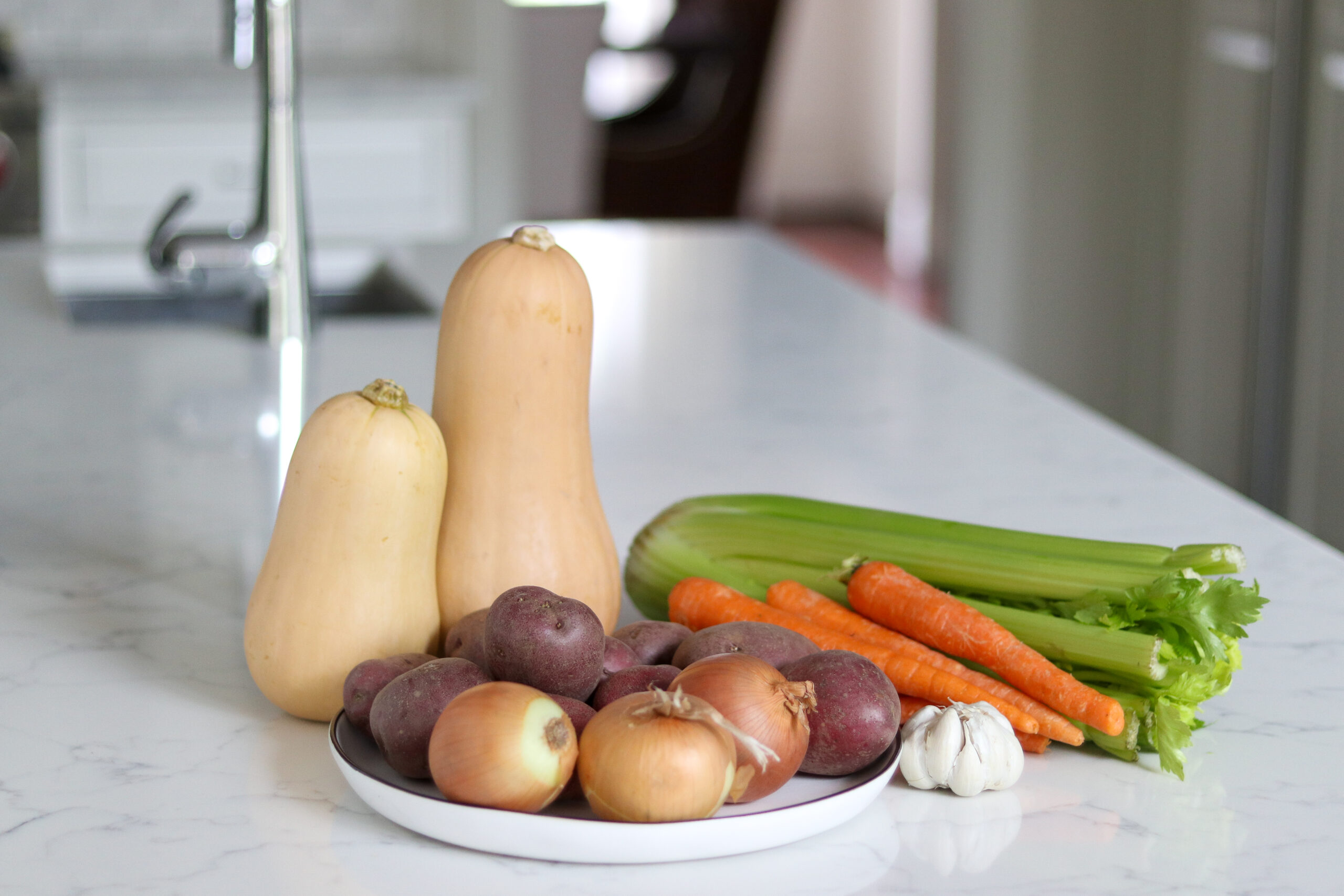
There are a few adjustments you can make to this recipe to suit your tastes. All of these variations follow guidelines for safe canning released by the National Center for Home Food Preservation.
You may choose to leave the other vegetables out of this recipe, and that’s fine. Make sure you do not mash or puree the squash until after canning. Mashed or pureed vegetables do not heat evenly inside a canning jar and so your finished product could be unsafe to eat.
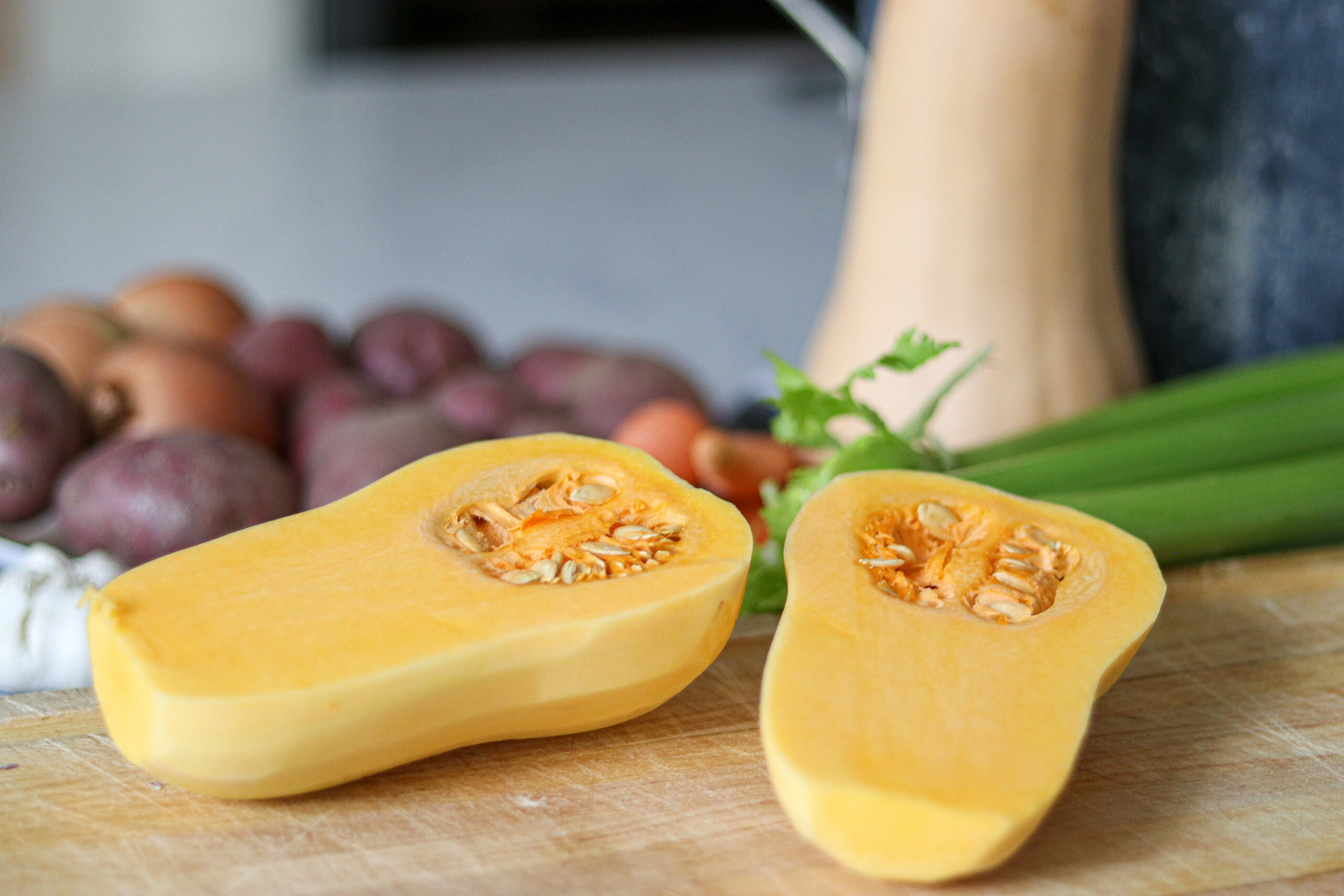
Another possible recipe variation is to add chicken stock (instead of veggie stock). You can add four cups of chicken stock for every five pounds of butternut squash you can, using this instead of water when you cover the jars.
You can also add spices and other herbs as you choose without having to worry about them affecting the safety of your finished product.
For a savory variation, try adding thyme and rosemary.
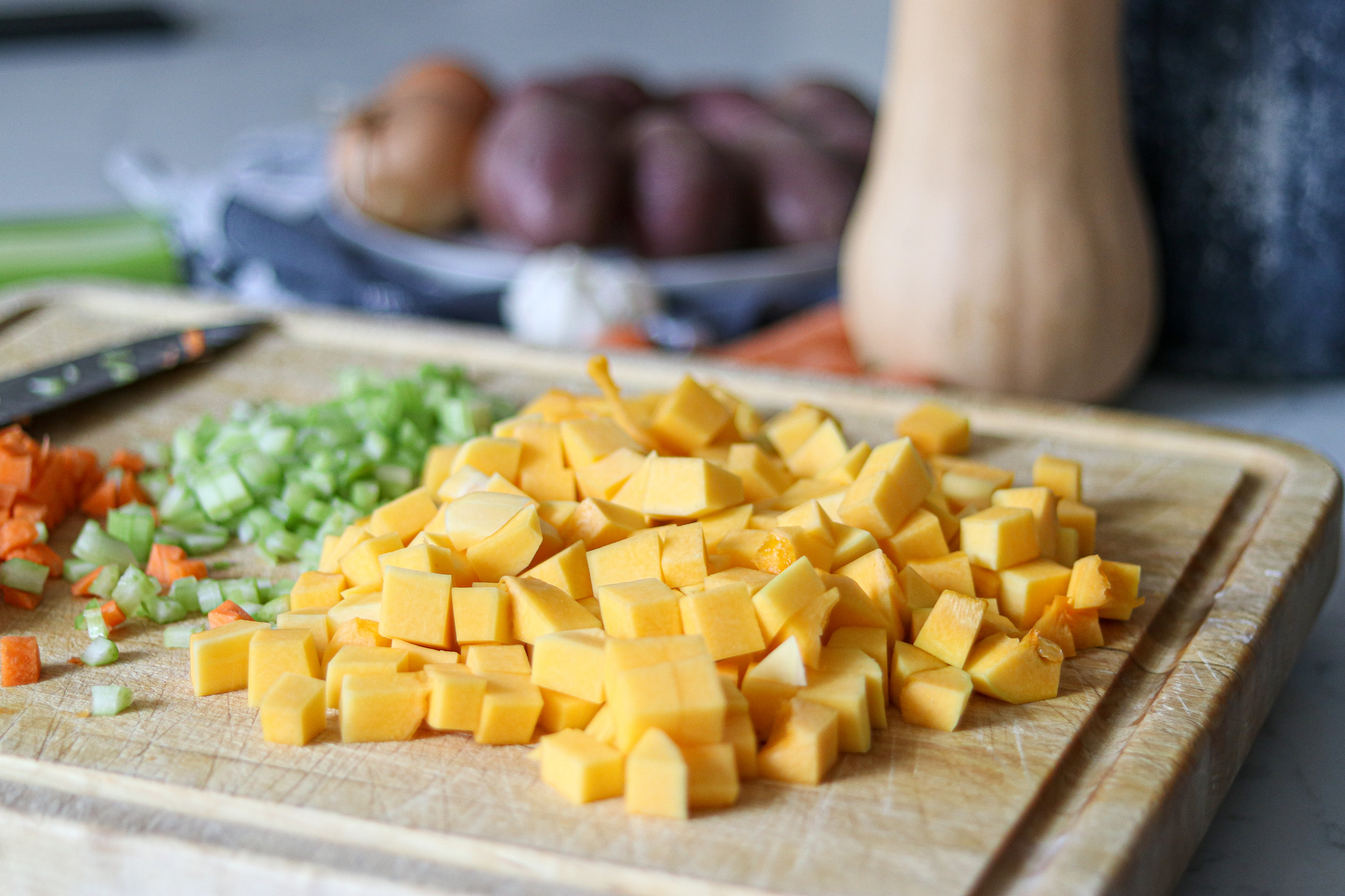
For a savory, earthy soup, add about ¼ teaspoon of nutmeg per quart.
For a Thai-style butternut squash soup, you might consider adding a tablespoon of red curry and two teaspoons of fresh chopped ginger.
Molasses, cinnamon, and a bit of allspice also work wonderfully.
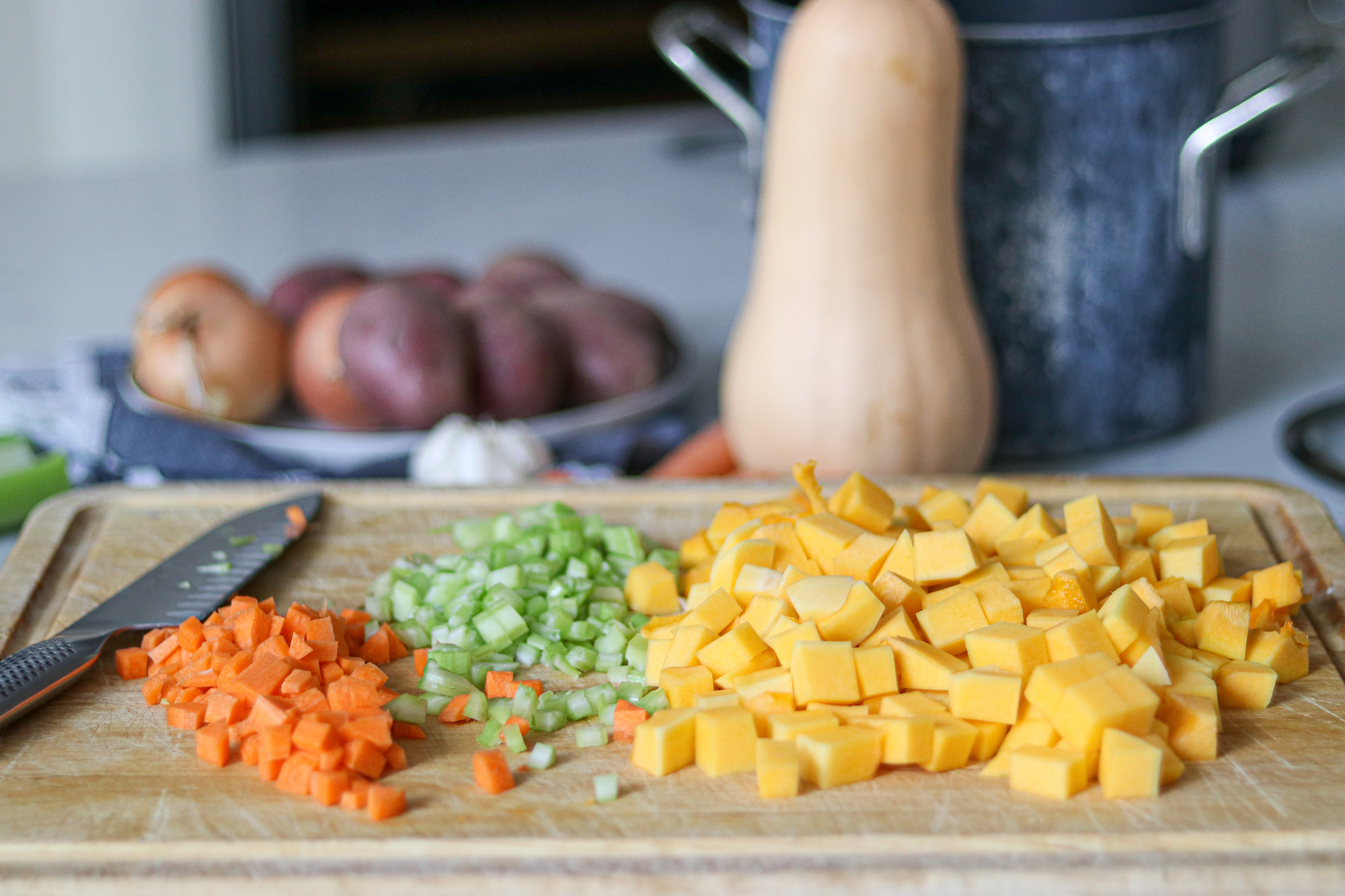
Canning Butternut Squash Soup Base
All vegetables should be washed thoroughly to remove any lingering traces of dirt, and the carrots, squash, and potatoes should all be peeled. Wash these vegetables before you peel them so you don’t drive dirt and bacteria into the flesh as you peel.
Your next step is cutting the squash, potatoes, celery, carrots, and onions into cubes.
You must also remove all seeds from the squash.
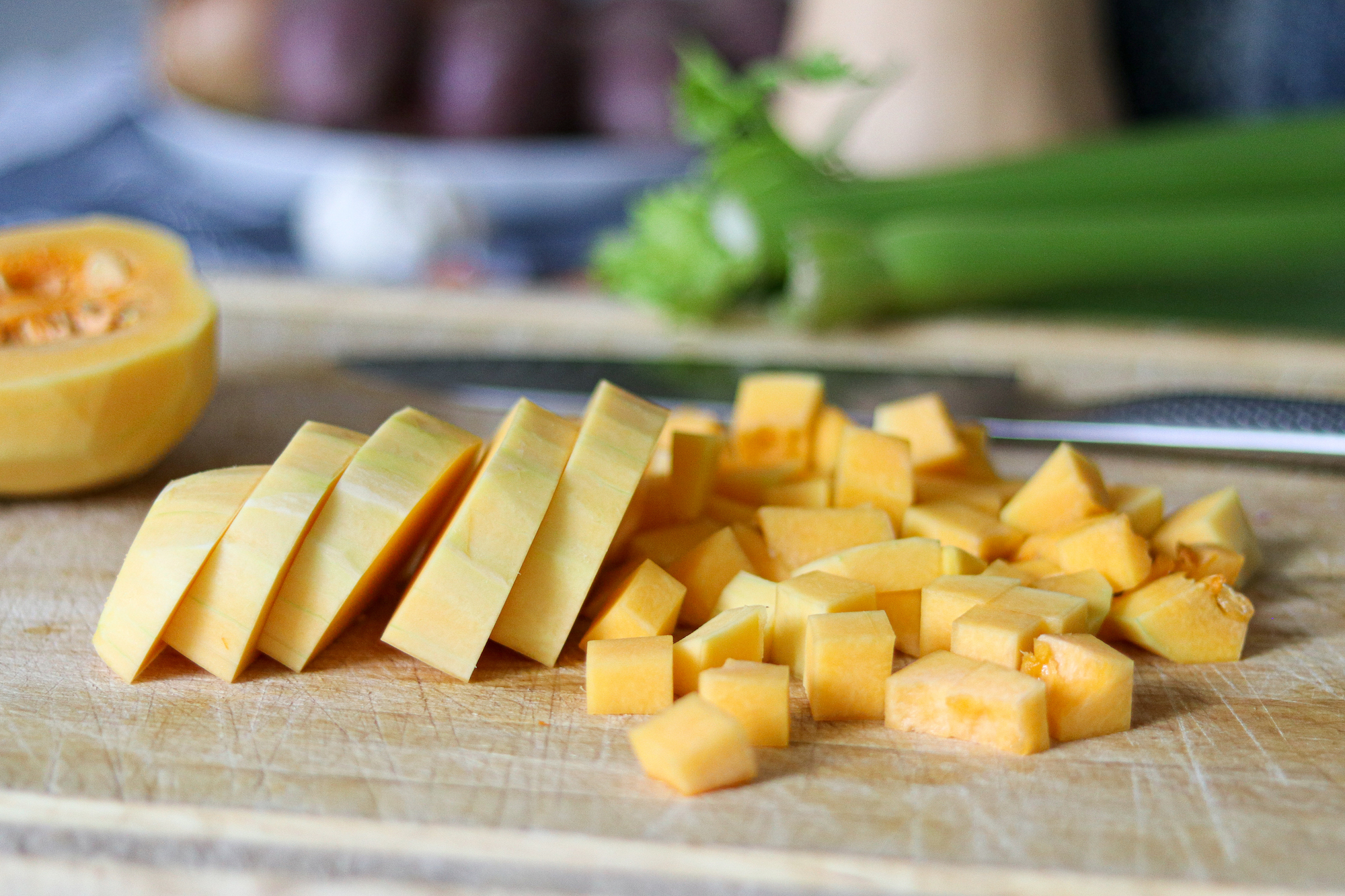
Put the potatoes and squash into a large stockpot. Cover with water, then bring to a low boil and boil for two minutes.
Avoid boiling for longer than two minutes, or the squash and other vegetables will break down and become mushy later on.
Add the remainder of the ingredients and mix to combine.
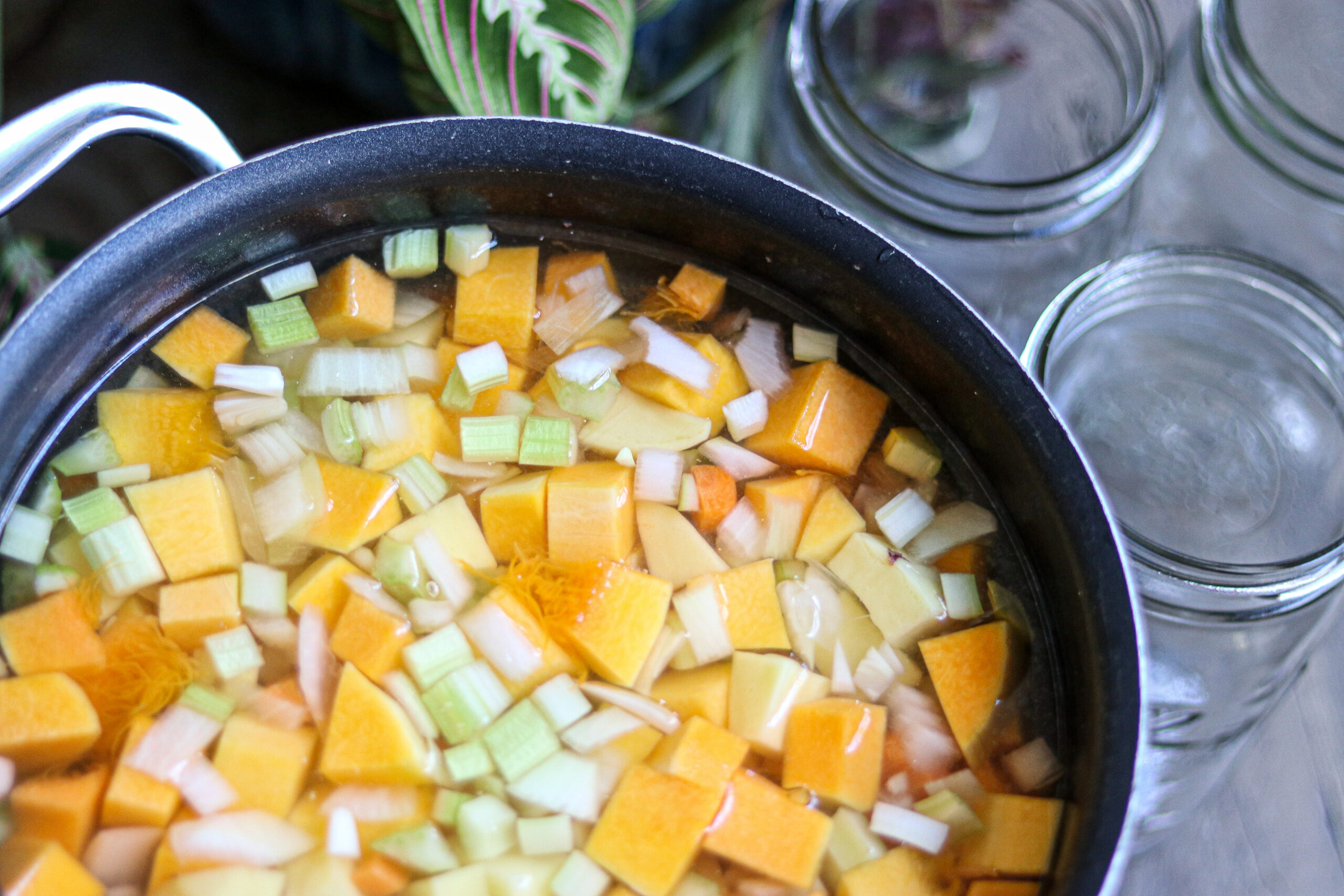
Put the hot mixture into jars, leaving an inch of headspace.
Ladle boiling water over the vegetables, making sure the inch of headspace still remains.
Remove air bubbles and wipe the lids to remove any food particles.
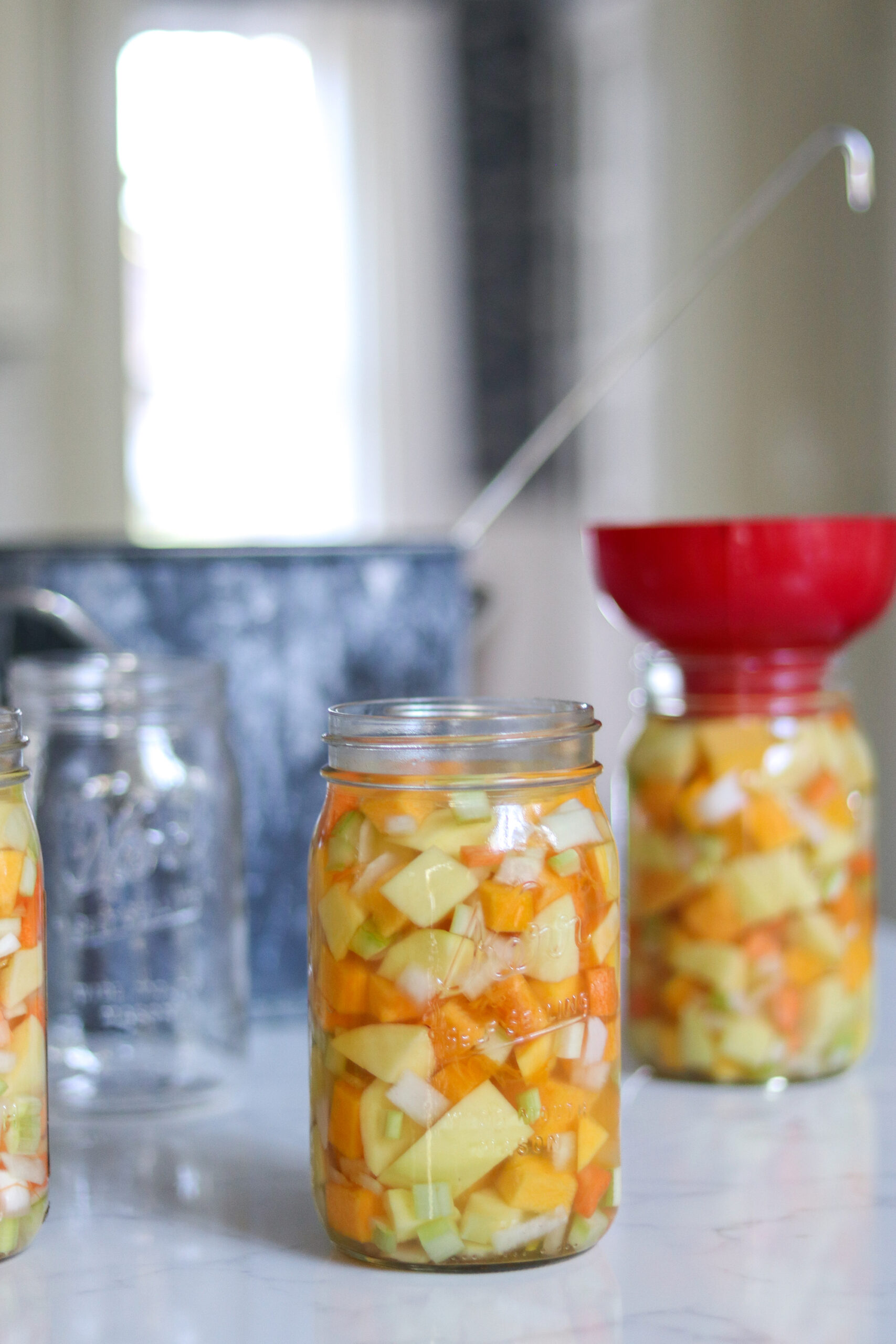
Process quarts for 90 minutes and pints for 75 minutes at 10 lbs of pressure, adjusting as needed for elevation.
When the canning time has elapsed, allow the canner to depressurize naturally. Then, remove the jars and allow them to cool for 24 hours before storing them.
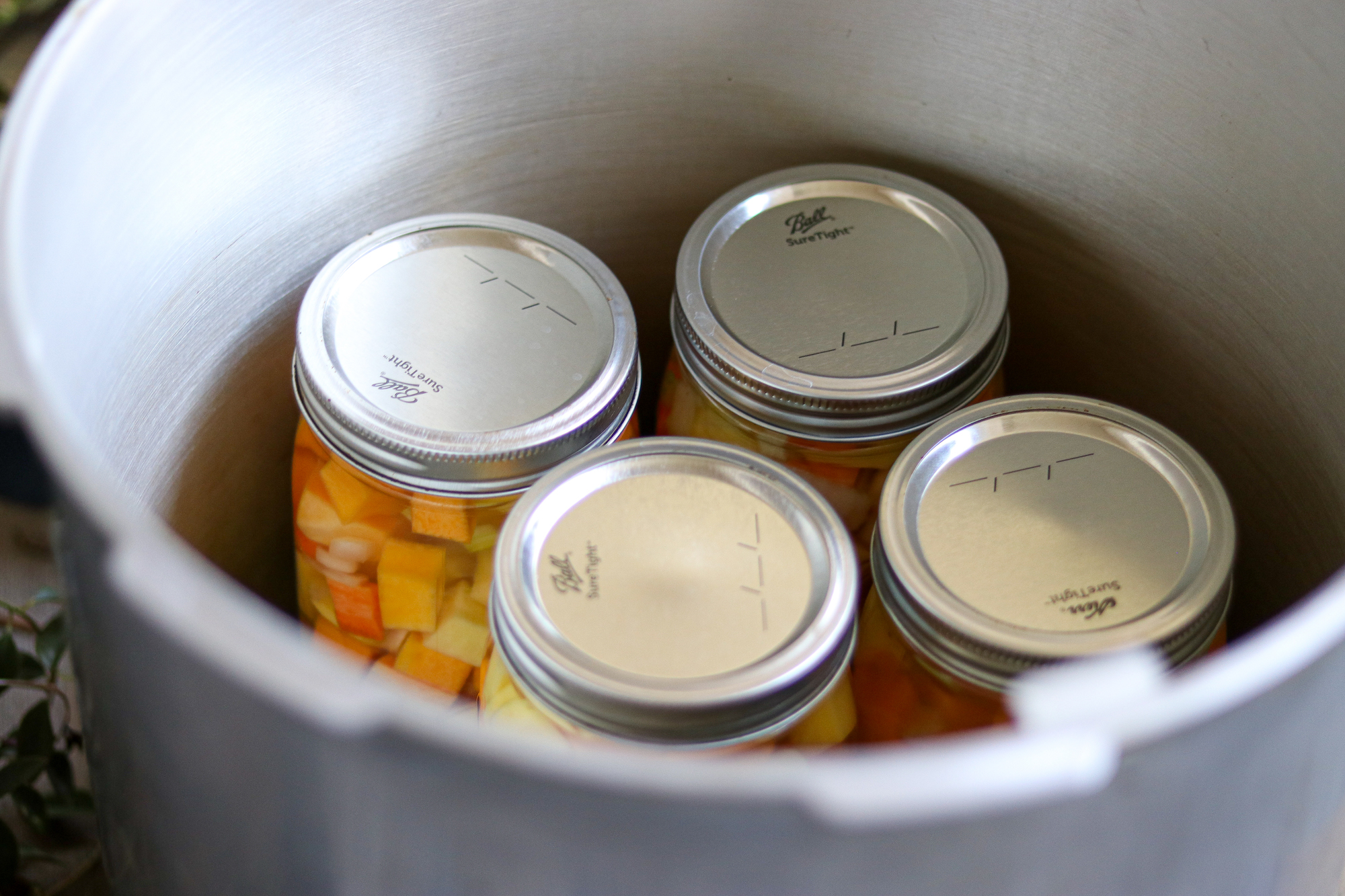
Altitude Adjustments for Canning Butternut Squash Soup Base
Canning time remains the same regardless of altitude. However, the processing pressure increases as altitude increases.
Use the following table to determine the correct processing pressure if you’re above 1,000 feet in elevation.
For dial gauge pressure canners:
- 0 to 2,000 feet in elevation – 11 lbs pressure
- 2,001 to 4,000 feet in elevation – 12 lbs pressure
- 4,001 to 6,000 feet in elevation – 13 lbs pressure
- 6,001 to 8,000 feet in elevation – 14 lbs pressure
For weighted gauge pressure canners:
- 0 to 1,000 feet in elevation – 10 lbs pressure
- Above 1,000 feet – 15 lbs pressure
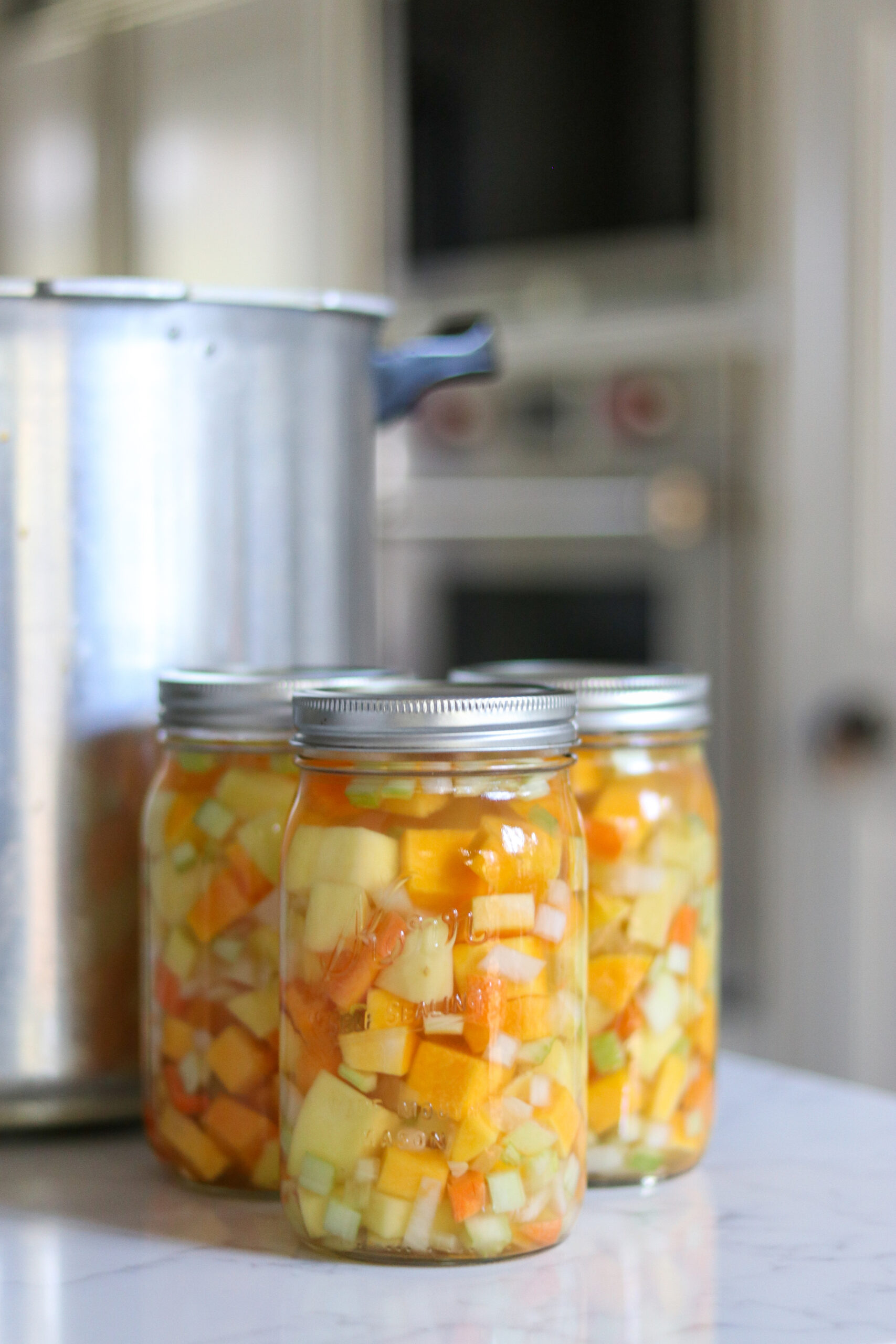
Butternut Squash Soup Variations
We’ve already discussed a number of variations in spicing, but you can go a bit further. There are other butternut squash (and pumpkin) soup canning recipes out there, and combining inspiration from more than one isn’t a bad idea.
I’m particularly fond of this recipe for butternut squash and white bean soup. It’s hearty and filling, with just enough butternut to give it amazing flavor.
For a really unique twist, you can also try the Thai Coconut Squash soup recipe that Ball Canning developed.
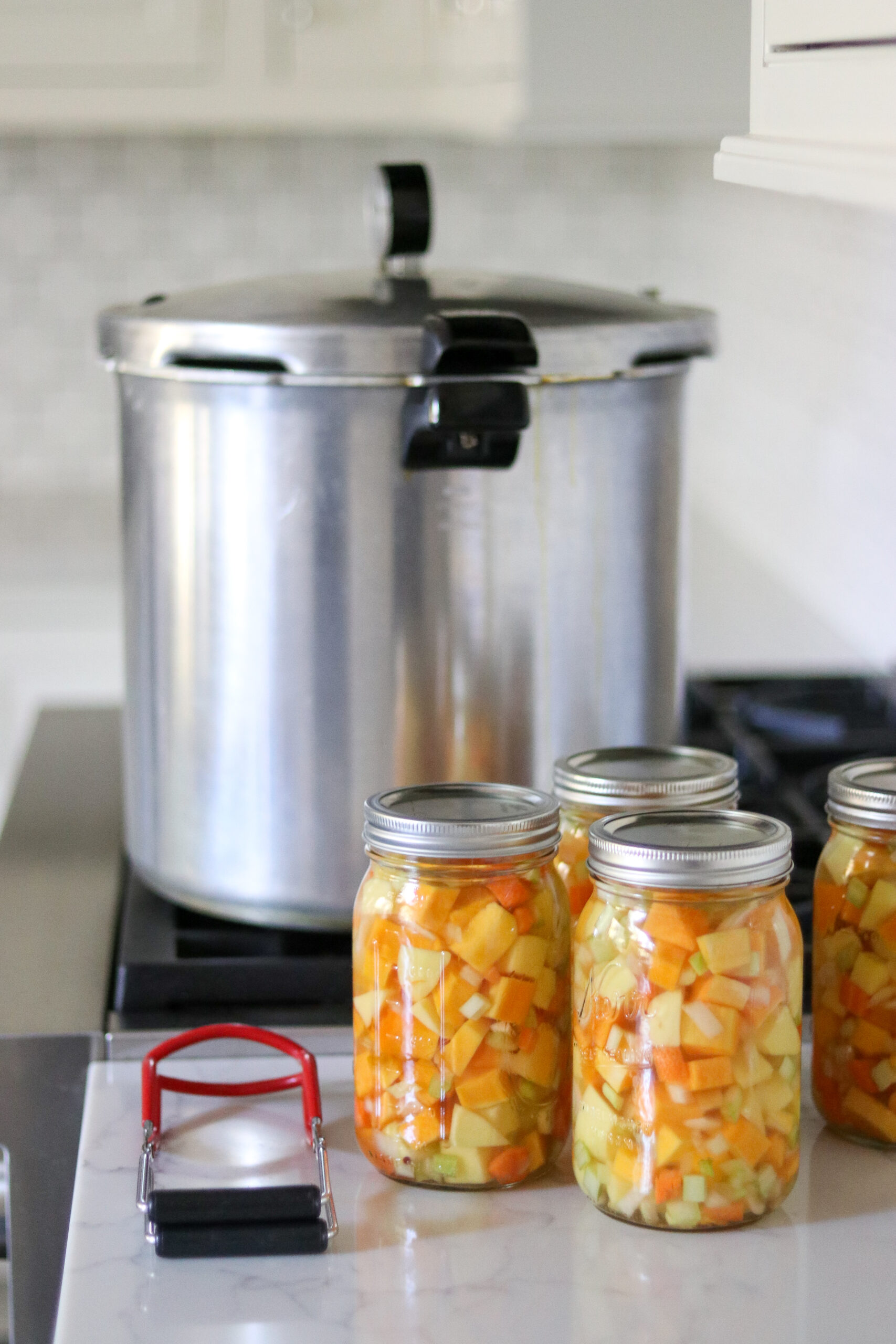
Serving Butternut Squash Soup Base
To serve, drain the water from the cans.
The only downside to canning butternut squash is that it tends to be the wateriest of all the winter squashes, so you will need to strain the excess liquid before you do anything with it.
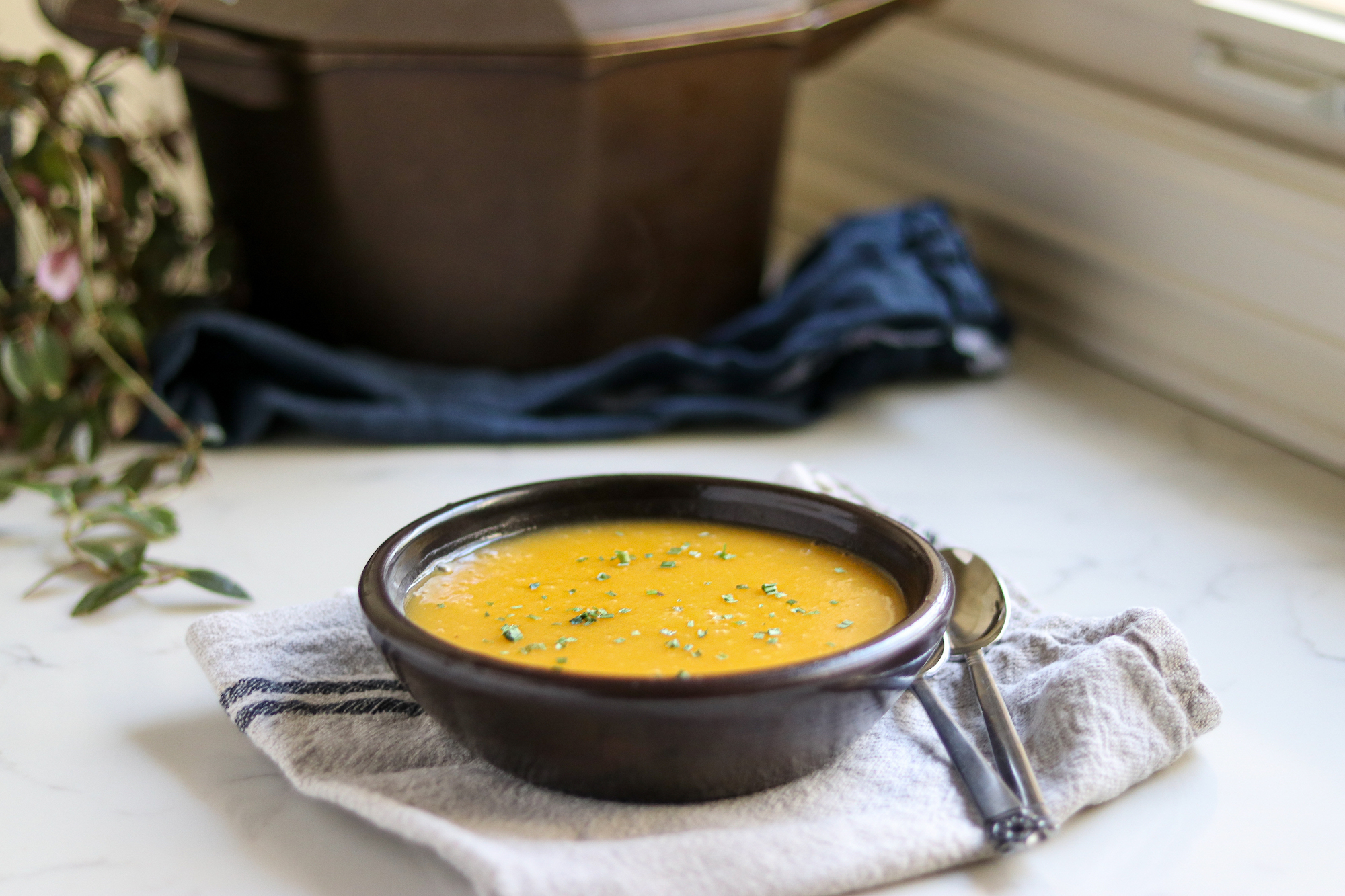
Then, puree in a blender for a smooth soup or mash with a potato masher for a coarse mix. Add a cup of cream or milk to the soup and heat, adding any other spices if desired (good choices are parsley, curry, ginger, and nutmeg).
Add a dollop of sour cream to each serving – and enjoy!
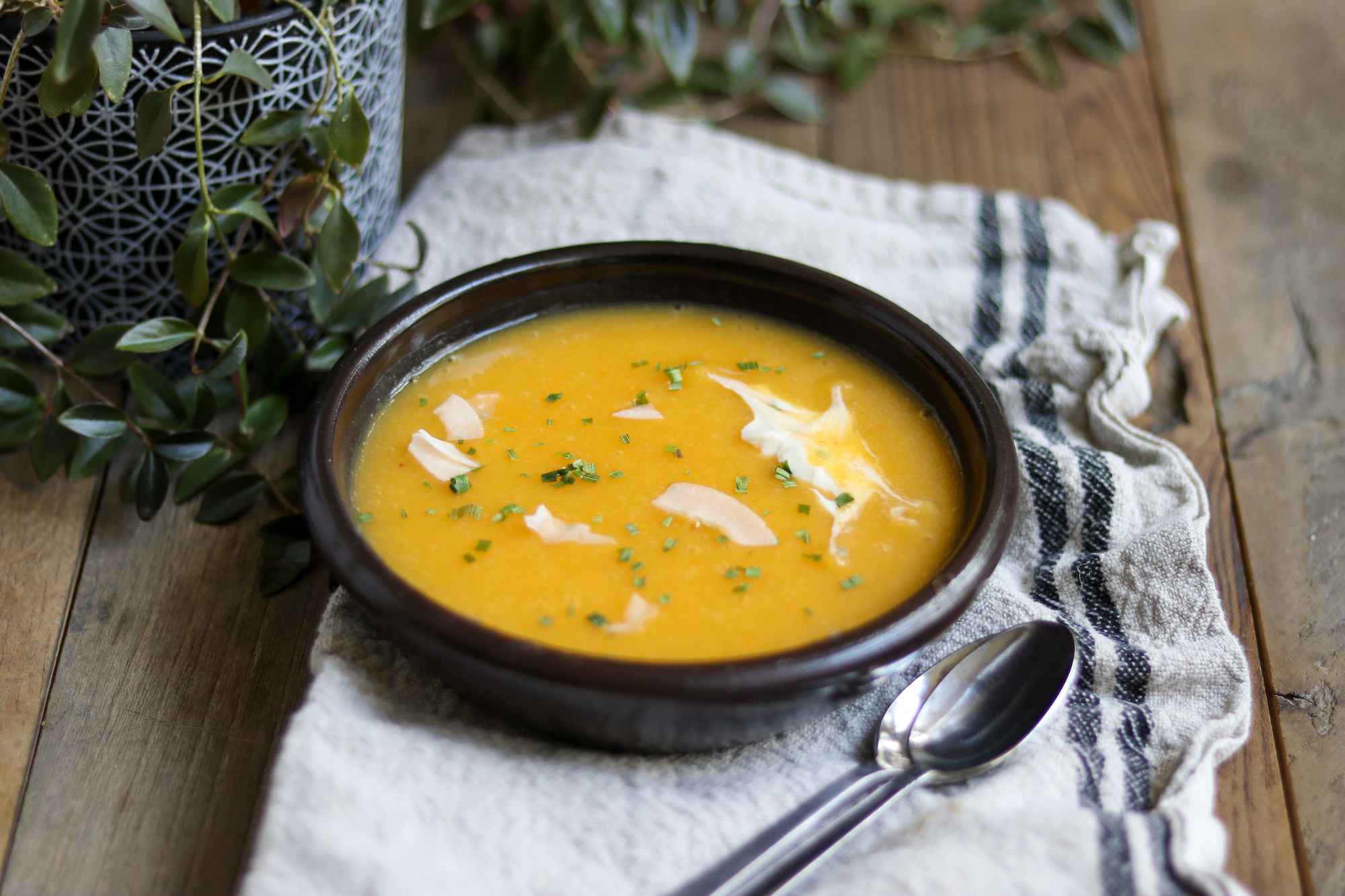
If you’d like to take your dinnertime game up a notch, you can add other ingredients to this soup or use it as a base for all kinds of different recipes.
Use it in a casserole, as a pasta sauce, or even as a base for more complex soups (some popular options include a butternut squash soup with apple, kale, and bacon, or even a butternut squash soup with goat cheese and sage).
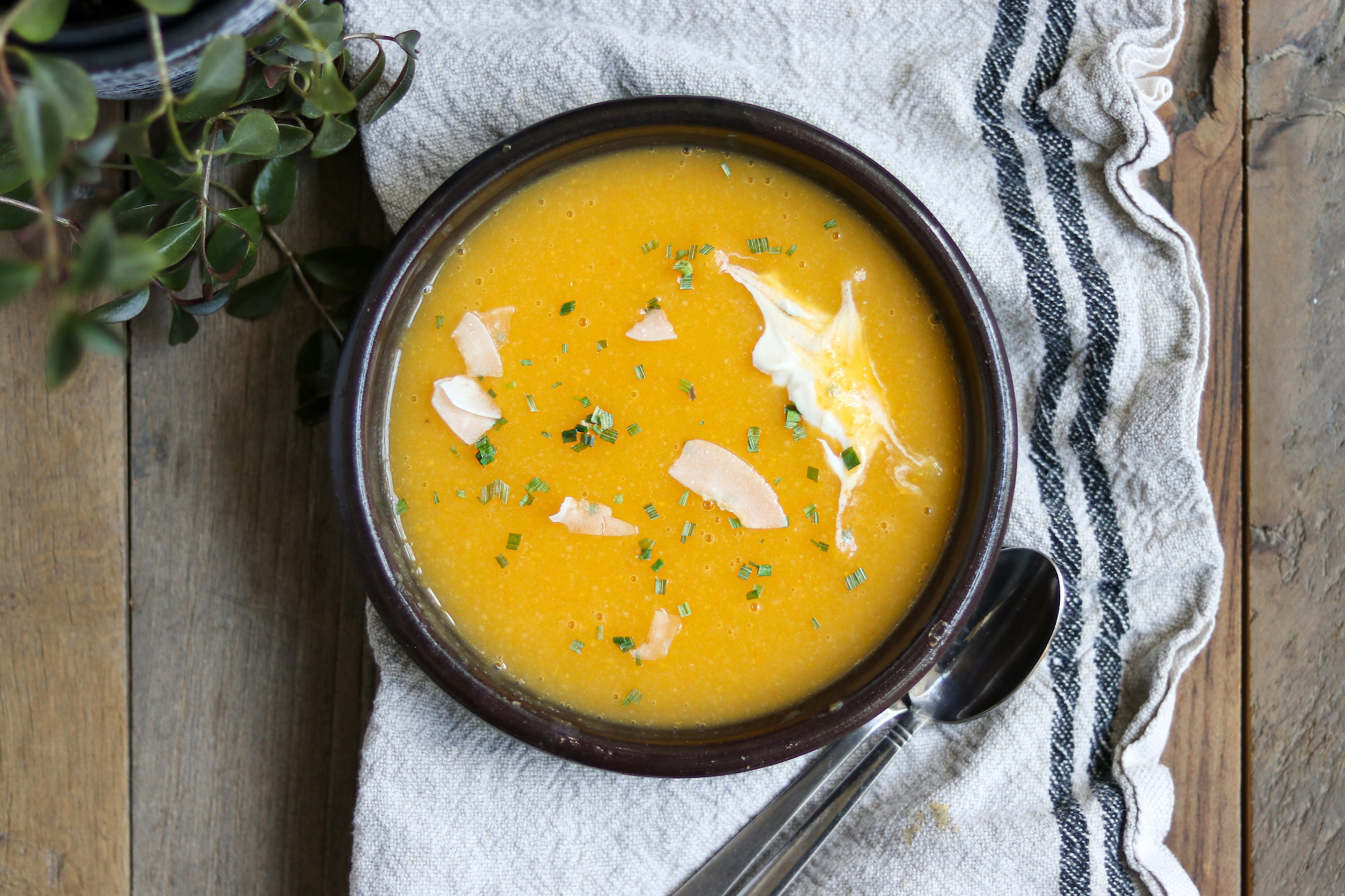
Soup Canning Recipes
There are so many different soup canning recipes out there, try these for your pantry:
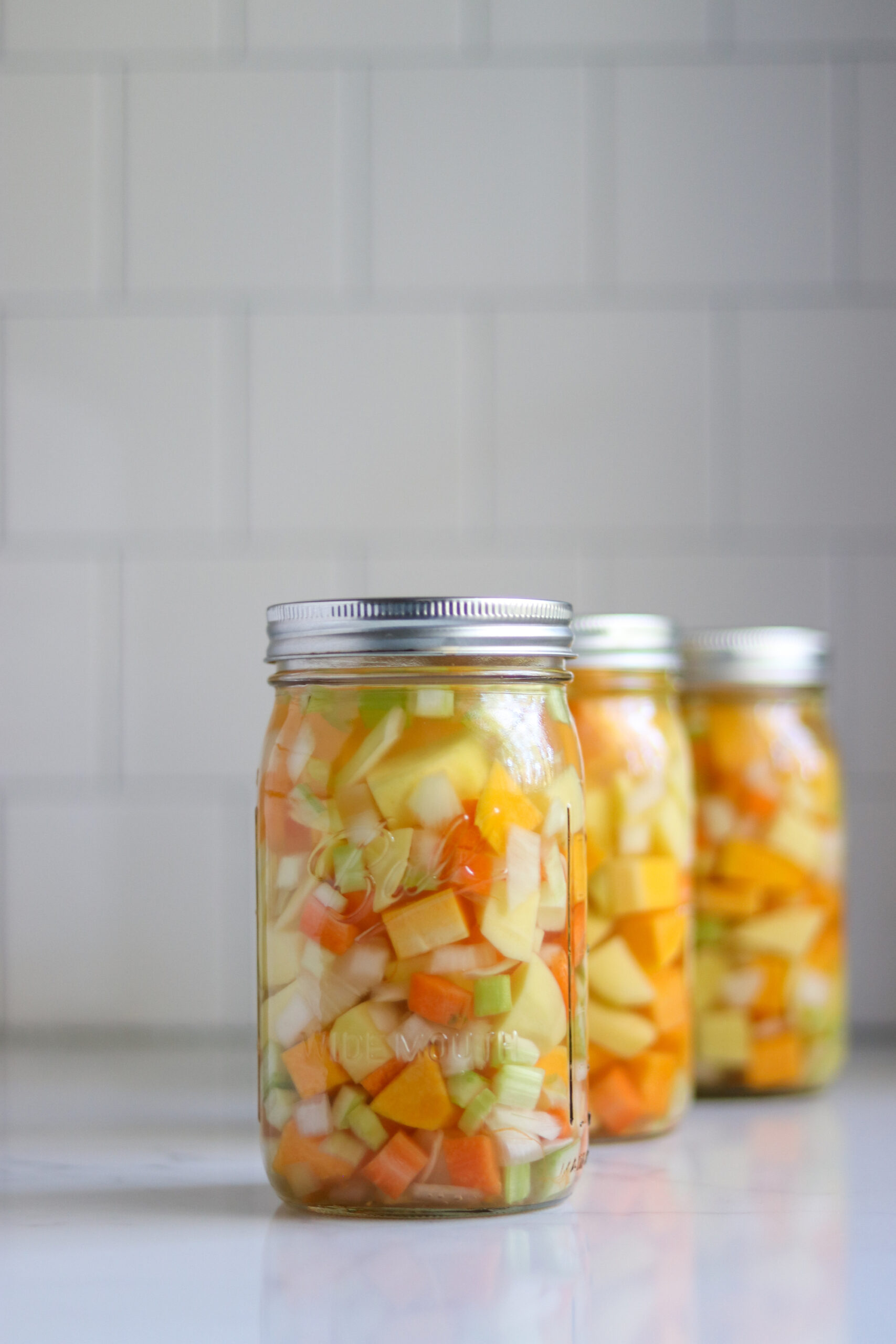
Meal in a Jar Canning Recipes
Need a few more meal-in-a-jar canning recipes?
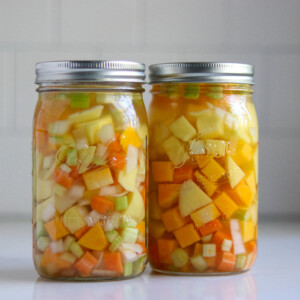
Canning Butternut Squash Soup Base
Equipment
Ingredients
- 5 lbs butternut squash, peeled and cubed into ½ inch pieces
- 2 ½ lbs red potatoes, peeled and cubed into ½ inch pieces
- 5 stalks celery, chopped
- 5 medium carrots, chopped
- 3 medium onions, chopped
- 2 Tbsp salt
- 3 Quart vegetable broth, chicken broth or water*
Instructions
- Wash the squash, onions, potatoes, celery, and carrots thoroughly. Peel the squash, carrots, and potatoes. Remove the seeds from the squash.
- Cut the squash, celery, carrots, onions, and potatoes into cubes.
- Put the potatoes and squash in a large stockpot. Cover with water, then bring to a boil and cook for two minutes.
- Add the remainder of the ingredients. Mix to combine.
- Put the hot vegetable mixture into jars, leaving an inch of headspace. Ladle boiling water over the vegetables, checking for the inch of headspace.
- Remove air bubbles and wipe the jars to remove food particles.
- Process in a pressure canner for 90 minutes (quarts) or 75 minutes (pints) at 10 lbs pressure. Adjust as needed for elevation, see notes.
- Allow the canner to depressurize, then remove the lid. Remove the jars and allow them to cool for 24 hours before storing.
Notes
Serving Butternut Squash Soup Base
To serve, drain the water from the cans. The only downside to canning butternut squash is that it tends to be the wateriest of all the winter squashes, so you will need to strain the excess liquid before you do anything with it. Then, puree in a blender for a smooth soup or mash with a potato masher for a coarse mix. Add a cup of cream or milk to the soup and heat, adding any other spices if desired (good choices are parsley, curry, ginger, and nutmeg). Add a dollop of sour cream to each serving - and enjoy! If you'd like to take your dinnertime game up a notch, you can add other ingredients to this soup or use it as a base for all kinds of different recipes. Use it in a casserole, as a pasta sauce, or even as a base for more complex soups (some popular options include a butternut squash soup with apple, kale, and bacon, or even a butternut squash soup with goat cheese and sage).Altitude Adjustments for Canning Butternut Squash Soup Base
Canning time remains the same regardless of altitude. However, the processing pressure increases as altitude increases. Use the following table to determine the correct processing pressure if you’re above 1,000 feet in elevation.For dial gauge pressure canners:
- 0 to 2,000 feet in elevation – 11 lbs pressure
- 2,001 to 4,000 feet in elevation – 12 lbs pressure
- 4,001 to 6,000 feet in elevation – 13 lbs pressure
- 6,001 to 8,000 feet in elevation – 14 lbs pressure
For weighted gauge pressure canners:
- 0 to 1,000 feet in elevation – 10 lbs pressure
- Above 1,000 feet – 15 lbs pressure
Nutrition
Nutrition information is automatically calculated, so should only be used as an approximation.
Canning Recipe Lists
Looking for more canning ideas?
- 100+ Canning Recipes from A to Z
- Pressure Canning Recipes
- Meat Canning Recipes
- 20+ Chicken Canning Recipes
- Soup Canning Recipes
- Meal in a Jar Canning Recipes
- Vegetable Canning Recipes
- Fruit Canning Recipes
- Root Vegetable Canning Recipes
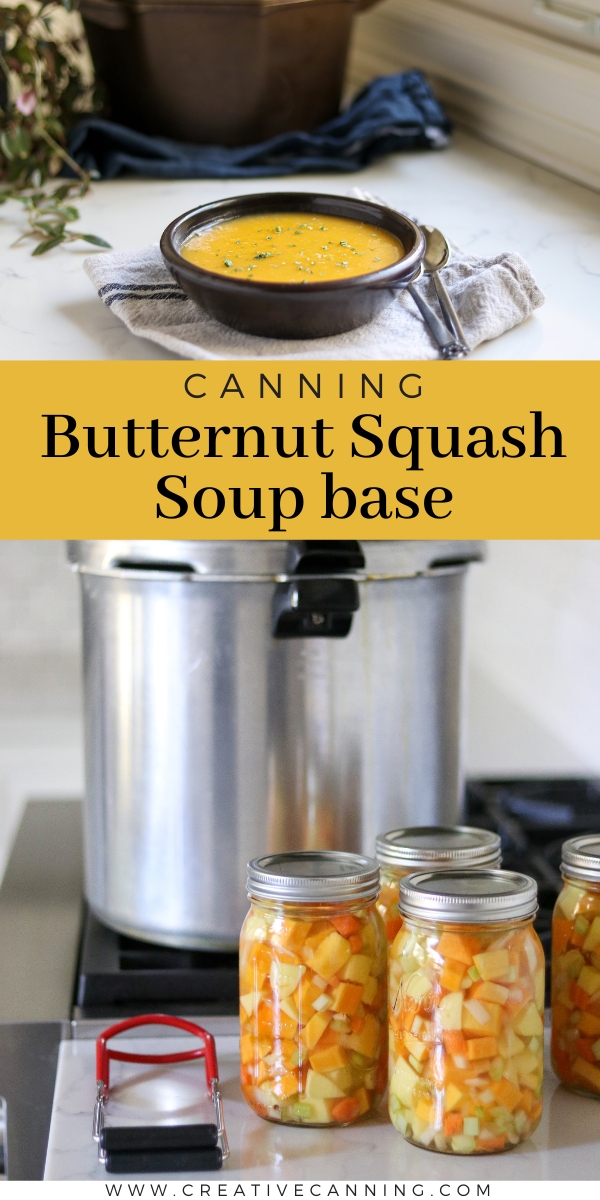
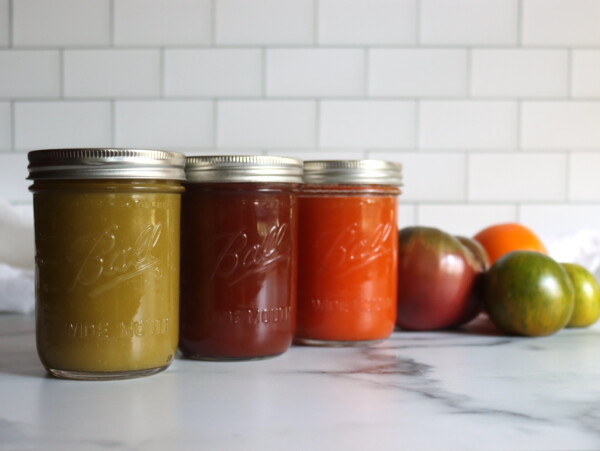
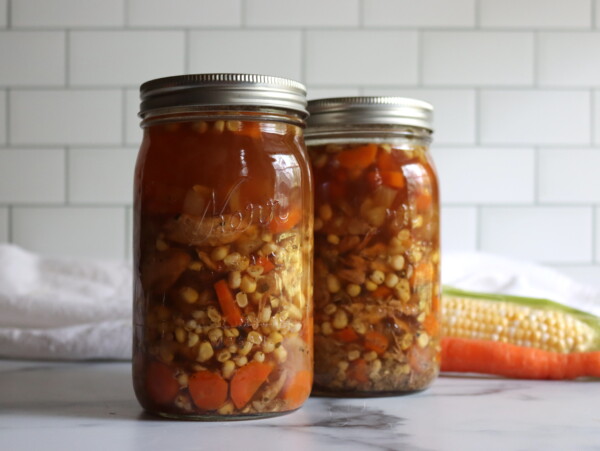
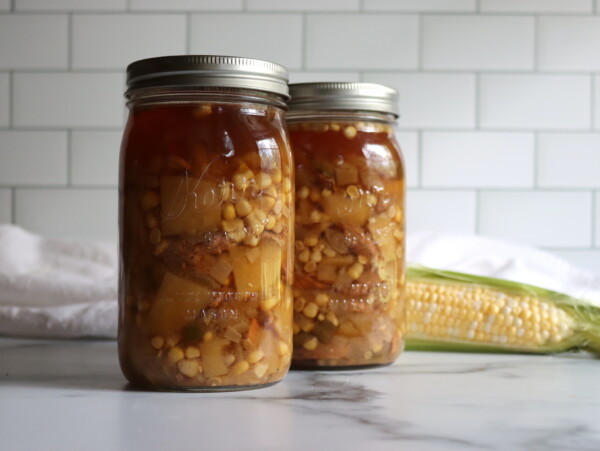
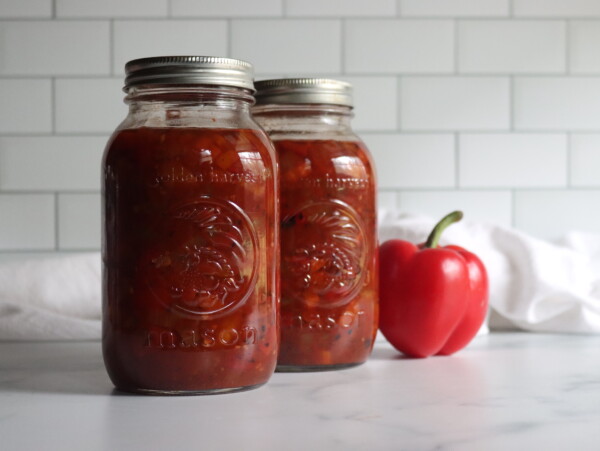
This looks amazing! Can I use a cushaw squash instead of butternut?
I have a cushaw that I need to use up. Thanks! My family has been enjoying your recipies this year.
I actually had to look that one up, as I’d never heard of Cushaw squash. In general, all winter squash are equivalent in canning recipes. The only exception is spaghetti type squash that string apart (and those aren’t approved for canning). Any firm fleshed winter squash can be used in this recipe (hubbard, pumpkin, kabocha, etc). Cushaw, from what I just read about it, should be just fine. Enjoy!
The recipe I usually use does not have potatoes, but has apples. Is it possible to substitute apples for potatoes?
Yes, that should be perfectly fine. Just be sure they’re very firm apples so they don’t fall apart into sauce in the jars, as they really should stay in whole chunks so the mixture doesn’t get too dense. Enjoy!
Hi! I can’t have white potatoes due to severe dietary restrictions. Could I potentially substitute sweet potato in instead? If not, could I just add more squash?
Thank you very much!
Yes, you could use either sweet potato or more squash. When you’re changing things up, just be sure to not overpack the jars so that there’s plenty of broth in there. The potatoes are in there to add a bit of creamy/starchy body to the soup, and another good substitute would be parsnips, which also have a similar nature. Enjoy!
I made this recipe this fall, and just served the first jar yesterday. It is so good! I dumped the whole jar including broth into the blender and blended it well. I wanted to taste it without added seasonings first, and it really doesn’t need anything. The variety of vegetables give it a nice depth of flavor.
Lovely! I’m so glad you enjoyed it!
Would it be safe to pressure can this recipe and include shredded chicken? There is a recipe I make just like this, but no potatoes, and with chicken, and serve over rice. Its delicious, and would be great if I could can with the added chicken.